Golden Driller of Tulsa
Erected for the 1953 International Expo, Tulsa’s towering roughneck grew into an Oklahoma landmark.
With an arm casually resting on a steel derrick, the 76-foot giant cannot be missed by visitors to the Tulsa County Fairgrounds. Popularly known as the “Golden Driller,” the first version of the 22-ton Oklahoma roughneck appeared in May 1953 as an oilfield supply company promotion during the Tulsa International Petroleum Exposition.
The leading oil and natural gas equipment expo, which began in 1923 as the International Petroleum Exposition and Congress, took place for decades at the Tulsa County Free Fair site. Tulsa independent producer William Skelly established the expo while he was serving as president of the Tulsa Chamber of Commerce.
In 1953, a golden “roustabout” statue conceived by the Mid-Continent Supply Company of Fort Worth, Texas, proved so popular it returned in 1959 after receiving a makeover.

Designated an Oklahoma state monument in 1979, the Golden Driller was permanently installed for the 1966 International Petroleum Exposition in Tulsa. Photo by Bruce Wells.
Another refurbishment and then neglect followed the fortunes of the petroleum industry. But civic leaders now proclaim the the Tulsa driller the most photographed landmark in the city once known as the “Oil Capital of the World.”
Although Mid-Continent Supply’s smaller first statue of 1952 impressed expo visitors, it was the 1959 version with an oilfield worker climbing a derrick that led to Tula’s current Golden Driller. “This time he was much more chiseled and detailed and was placed climbing a derrick and waving,” explained a volunteer for the Tulsa Historical Society in 2010.
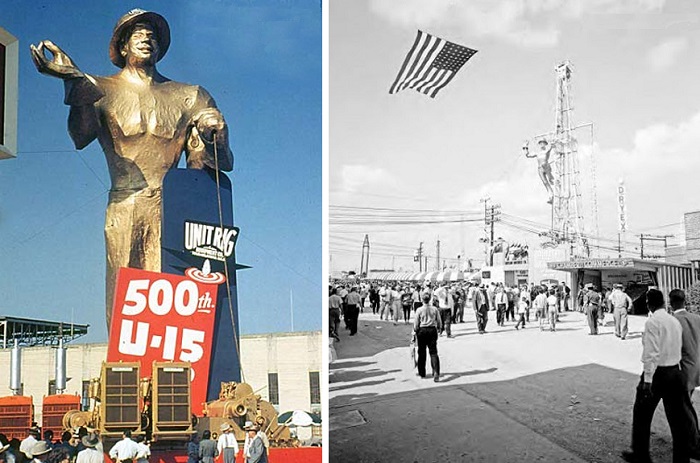
The original Golden Driller of 1953, left, proved so popular that a smaller, rig-climbing version (called The Roustabout) returned for the 1959 International Petroleum Exposition. The Tulsa fairgrounds opened in 1903. Images courtesy Tulsa Historical Society.
According to the society’s “Tulsa Gal,” the 1959 rig-climbing roustabout’s popularity inspired Mid-Continent Supply to donate it to the Tulsa County Fairgrounds Trust Authority when the international expo ended. Sometime during the next seven years, the giant was redesigned to better withstand the elements, she noted.
Taller and much stronger, the modern Golden Driller debuted in 1966 at Tulsa’s International Petroleum Exposition. The new look came from a Greek immigrant, George “Grecco” Hondronastas, an artist who had worked on the 1953 exposition’s hard-hatted statue.
According to writer Tony Beaulieu, Hondronastas was an eccentric and prolific artist who was proud of becoming a U.S. citizen through military service in World War I. He attended the Art Institute of Chicago and later became a professor. His design work included business promotions and parade floats.
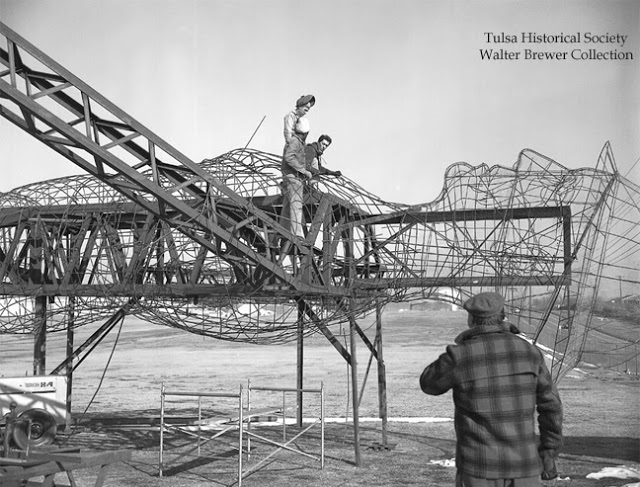
Mid-Continent Supply Company constructed a permanent version in 1966 with steel rods to withstand up to 200 mph winds but more work would be needed. The giant was refurbished again in 1979, after it was designated an Oklahoma state monument.
Hondronastas came to Tulsa for the first time in 1953, “to help design and build an early version of the Golden Driller,” explained Beaulieu, who also noted the artist “fell in love with the city of Tulsa and later moved his wife and son from Chicago to a duplex near Riverview Elementary School, just south of downtown.”
The artist was immensely proud of designing the Golden Driller — “and he would tell that to anyone he met,” added his son Stamatis, quoted in Beaulieu’s 2014 article, “An Oil Town’s Golden Idol, “ in This Land magazine.
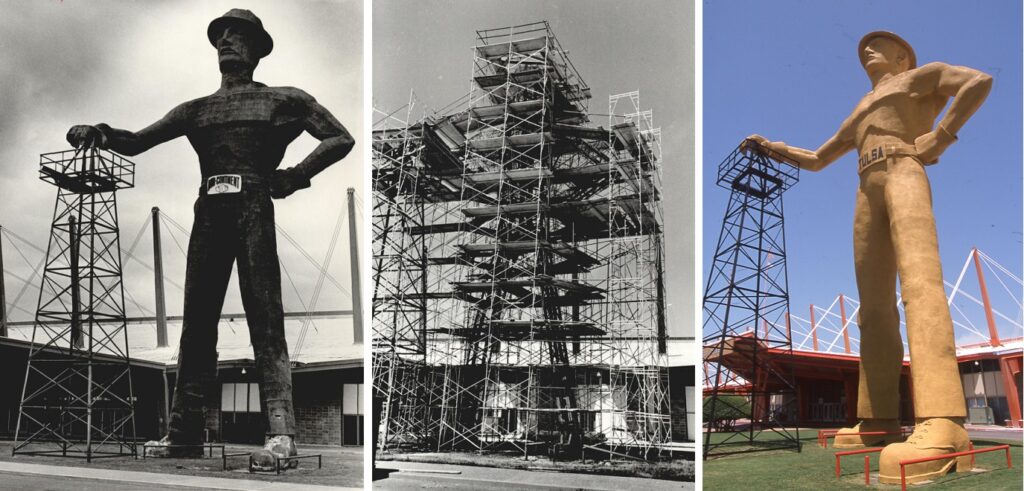
“The battered Golden Driller statue has been declared an official state monument,” noted the Daily Oklahoma more than a decade after Mid-Continent Supply donated its 1966 version to the Tulsa County Fairgrounds. Rebuilt in 1979 (center), the modern statue has was repainted in 2011. Photos courtesy Oklahoma Historical Society.
The late Tulsa photographer Walter Brewer documented construction of the giant with images later donated to the Tulsa Historical Society. Designated a state monument and refurbished again in 1979 (the year Hondronastas died), the statue as it appears today was permanently installed at East 21st Street and South Pittsburg Avenue.
The statue contains 2.5 miles of rods and mesh, along with tons of plaster and concrete. It can withstand up to 200 mph winds, “which is a good thing here in Oklahoma,” according to Tulsa Gal. It was painted it’s golden mustard shade in 2011,
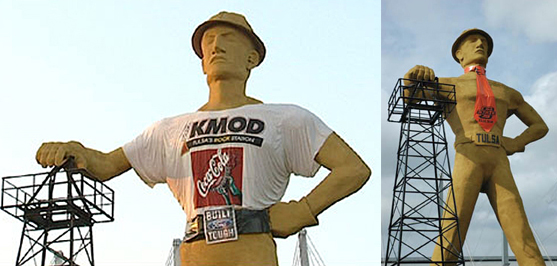
Tulsa’s giant driller has sported t-shirts, belts, beads, neckties and other promotions during state fairs. A Covid-19 mask was added in the summer of 2020. Images courtesy the Tulsa Historical Society.
The Golden Driller’s right hand rests on an old production derrick moved from oilfields near Seminole, Oklahoma — a town that has its own extensive petroleum heritage.
Fully refurbished in the late 1970s, the Golden Driller — by now a 43,500-pound tourist attraction — is the largest free-standing statue in the world, according to Tulsa city officials. “Over time the Driller has seen the good and the bad,” said Tulsa Girl.
“He has been vandalized, assaulted by shotgun blasts and severe weather,” she added. “But he has also had more photo sessions with tourists than any other Tulsa landmark and can boast of many who love him all around the world.”
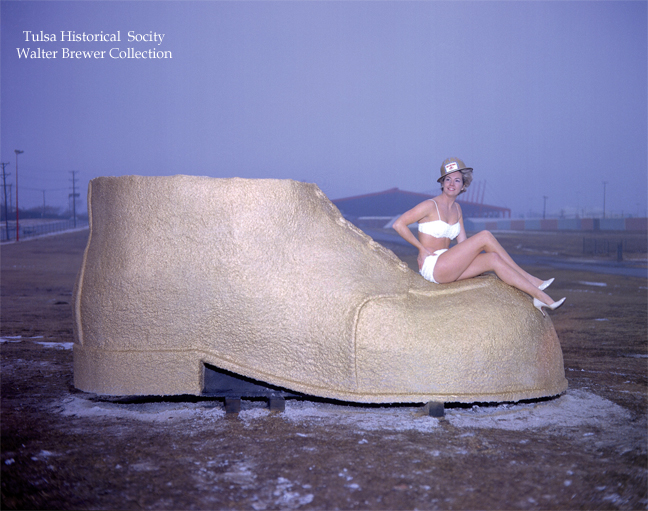
An unidentified model posed on one of the Golden Driller’s shoes, probably sometime during construction of the permanent version in time for the opening of Tulsa’s 1966 International Petroleum Exposition.
The Golden Driller, a symbol of the International Petroleum Exposition. Dedicated to the men of the petroleum industry who by their vision and daring have created from God’s abundance a better life for mankind. — Inscription on a plaque at the Golden Driller’s base.
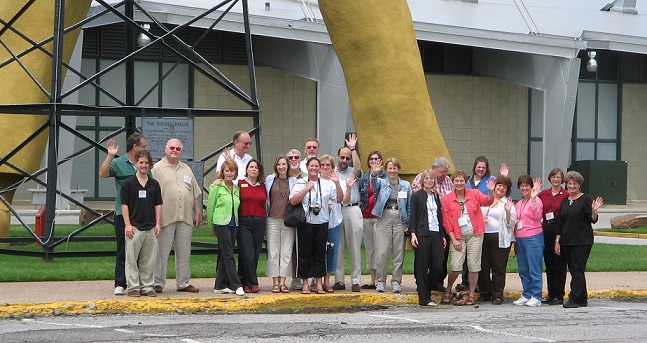
An American Oil & Gas Historical Society 2007 Energy Education Conference and Field Trip in Oklahoma City included visits to oil museums in Seminole, Drumright and Tulsa — with a stop at the Golden Driller. Photo by Timothy G. Wells.
Although the first International Petroleum Exposition and Congress had no giant roughneck statue in 1923, the expo helped make Tulsa famous around the world. Leading oil and gas companies were attracted to Tulsa as early as 1901, six years before Oklahoma became a state (learn more in Red Fork Gusher).
An even bigger oilfield discovery arrived in 1905 on a farm south of the future oil capital. On November 22, 1905, the Ida Glenn No. 1 well erupted a geyser of oil southeast of Tulsa. The giant Glenn Pool field would forever change Tulsa and Oklahoma.
Learn more Tulsa history in the extensive collection of the Tulsa Historical Society.
_______________________
Recommended Reading: Tulsa Oil Capital of the World, Images of America (2004); Tulsa Where the Streets Were Paved With Gold – Images of America
(2000). Your Amazon purchase benefits the American Oil & Gas Historical Society. As an Amazon Associate, AOGHS earns a commission from qualifying purchases.
_______________________
The American Oil & Gas Historical Society (AOGHS) preserves U.S. petroleum history. Please become an AOGHS annual supporter and help maintain this energy education website and expand historical research. For more information, contact bawells@aoghs.org. © 2025 Bruce A. Wells. All rights reserved.
Citation Information – Article Title: “Golden Driller of Tulsa.” Authors: B.A. and K.L. Wells. Website Name: American Oil & Gas Historical Society. URL: https://aoghs.org/oil-almanac/golden-driller-tulsa. Last Updated: May 17, 2025. Original Published Date: March 1, 2006.



